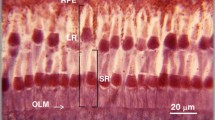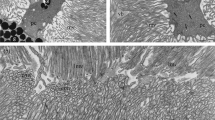Summary
The cytological influence of light and dark adaptation (LA and DA) on the retinular cells of the spider crab Libinia emarginata has been studied by light and electron microscopy in four adaptive states: 17 hours darkness, 5 hours darkness, 5 hours diffuse light and 17 hours diffuse light. The rhabdom's fine structure is typical of decapods but its dual overall form and position mingle certain features of both apposition and superposition compound eye types. Distal and proximal retinal pigments both showed adaptive migration, but the distal pigment cells moved over a restricted range, and DA separated the retinular cell pigment granules into two groups, perinuclear and basilar.
In the rhabdom no changes in its position, dimensions or microvillus fine structure were observed with LA or DA. But at the base of the rhabdom microvilli the rate of pinocytosis was strongly affected by the eye's adaptive state, being lowest after 17 hours DA and greatest after 17 hours LA; the wall of the 0.1 μ microvesicles so formed, looked like the membrane of the rhabdom microvillus and they were the same size as the vesicles in multivesicular bodies and in vesicular lamellar bodies.
Three categories of complex cytoplasmic particles about 1 μ in diameter (multivesicular bodies, vesicular lamellar bodies and purely lamellar bodies) were all increased in number by decreased DA and by increased LA; similar quantitative effects occurred in the endoplasmic reticulum and in the ribosomes.
The pinocytotic vesicles and the complex cytoplasmic bodies may represent part of an intracellular system to dispose of rhabdom metabolites whose production was initiated or increased by light absorption.
Cytoplasmic and perirhabdomal vacuoles mainly distal in location, were also affected by light, but inversely; their maximal extent occurred after 17 hours DA; less DA or any LA significantly decreased their presence and aggregation.
The data reported are of interest not only because they correlate retinal fine structure with the metabolism of vision but also because they provide a new and specific tool for distinguishing active from inactive neurosensory cells in the optic pathway.
Similar content being viewed by others
References
Baccetti, B., and C. Bedini: Research on the structure and physiology of the eye of a lycosid spider. I. Microscopic and ultramicroscopic structure. Arch. ital. Biol. 102, 97–122 (1964).
Bedau, K.: Das Facettenauge der Wasserwanzen. Z. wiss. Zool. 97, 417–456 (1911).
Bennitt, R.: The migration of retinal pigment in crustaceans. J. exp. Zool. 40, 381–435 (1924).
Bernard, F.: Recherches sur la morphogénèse des yeux composés d'arthropodes. Bull. biol. France et Belg. 23, (Suppl.), 1–162 (1937).
Bernhard, C. G. (ed.): Functional organization of the compound eye. Wenner Gren Center Internat. Symp. Series. vol. 7, 591 p. Oxford: Pergamon Press 1966.
Brazier, M. A. B. (ed.): Brain function, vol. II., 360 p. Berkeley-Los Angeles: University of California Press 1964.
Brown, F. A. jr.: Physiological rhythms. In: The physiology of Crustacea (ed. T. H. Waterman), vol. II, p. 401–430. New York: Academic Press 1961.
Burkhardt, D.: Spectral sensitivity and other response characteristics of single visual cells in the arthropod eye. In: Biological receptor mechanisms (ed. J. W. L. Beament), Symp. Soc. exp. Biol. 16, 86–109 (1962).
Dowling, J. E.: Chemistry of visual adaptation in the rat. Nature (Lond.) 188, 114–118 (1960).
— and I. R. Gibbons: The effect of vitamin A deficiency on the fine structure of the retina. In: The structure of the eye (ed. G. K. Smelser), p. 85–99. New York: Academic Press 1961.
— The fine structure of the pigment epithelium in the albino rat. J. Cell Biol. 14, 459–474 (1962).
Duve, C. de, and R. Wattiaux: Functions of lysosomes. Ann. Rev. Physiol. 28, 435–492 (1966).
Eakin, R. M., W. B. Quay, and J. A. Westfall: Cytochemical and cytological studies of the parietal eye of the lizard, Sceloporus occidentalis. Z. Zellforsch. 53, 449–470 (1961).
— Cytological and cytochemical studies on the frontal and pineal organs of the treefrog, Hyla regilla. Z. Zellforsch. 59, 663–683 (1963).
Eguchi, E.: Rhabdom structure and receptor potentials in single crayfish retinular cells. J. cell. comp. Physiol. 66, 411–430 (1965).
— and T. H. Waterman: Fine structure patterns in crustacean rhabdoms. In: Functional organization of the compound eye (ed. C. G. Bernhard), Wenner Gren Center Internat. Symp. Series, vol. 7, p. 105–124. Oxford: Pergamon Press 1966.
Exner, S.: Die Physiologie der facettirten Augen von Krebsen und Insecten, 206 S. Leipzig u. Wien: Franz Deuticke 1891.
Fawcett, D. W.: The cell, 448 p. Philadelphia: W. B. Saunders Co. 1966.
Fernández-Morán, H.: Fine structure of the light receptors in the compound eyes of insects. Exp. Cell Res., Suppl. 5, 586–644 (1958).
Genest, A. A.: An analysis of dark adaptation in two crustacean forms, Callinectes sapidus and Procambarus sp., 64. p. Thesis Yale University, New Haven, Conn. 1961.
Goldsmith, T. H.: The course of light and dark adaptation in the compound eye of the honey-bee. Comp. Biochem. Physiol. 10, 227–237 (1963).
— The visual system of insects. In: The physiology of Insecta (ed. M. Rockstein), vol. I, p. 397–462. New York: Academic Press 1964.
Höglund, G.: Pigment migration and retinular sensitivity. In: Functional organization of the compound eye (ed. C. G. Bernhard), Wenner Gren Center Internat. Symp. Series., vol. 7, p. 77–88. Oxford: Pergamon Press 1966.
Horridge, G. A., and P. B. T. Barnard: Movement of palisade in locust retinula cells when illuminated. Quart. J. micr. Sci. 106, 131–135 (1965).
Hydén, H.: The neuron. In: The cell (ed. J. Brachet and A. E. Mirsky), vol. IV, p. 215–323 London: Academic Press 1960.
— RNA — A functional characteristic of the neuron and its glia. In: Brain function (ed. M. A. B. Brazier), vol. II, p. 29–68. Berkeley-Los Angeles: University of California Press 1964.
Kleinholz, L. H.: Pigmentary effectors. In: The physiology of Crustacea (ed. T. H. Waterman), vol. II, p. 133–169. New York: Academic Press 1961.
— Hormonal regulation of the retinal pigments. In: Functional organization of the compound eye (ed. C. G. Bernhard), Wenner Gren Center Internat. Symp. Series, vol. 7, p. 89–101. Oxford: Pergamon Press 1966.
Kogan, A. B.: Electrical activity and RNA of brain cells. In: Brain function (ed. M. A. B. Brazier), vol. II, p. 345–349. Berkeley-Los Angeles: University of California Press 1964.
Kreutzberg, G. W., and H. Hager: Electron microscopical demonstration of acid phosphatase activity in the central nervous system. Histochemie 6, 254–259 (1966).
Langer, H.: Spektrometrische Untersuchung der Absorptionseigenschaften einzelner Rhabdomere in Facettenauge. Zool Anz., Suppl. 29, 329–338 (1966).
— and B. Thorell: Microspectrophotometry of single rhabdomeres in the insect eye. Exp. Cell Res. 41, 673–677 (1966).
Mayrat, A.: Premier résultats d'une étude au microscope électronique des yeux des Crustacés. C. R. Acad. Sci. 255, 766–768 (1962).
Miller, F., and G. E. Palade: Lytic acitvities in renal protein absorption droplets. An electron microscopical cytochemical study. J. Cell Biol. 23, 519–552 (1964).
Morrell, F.: Lasting changes in synaptic organization produced by continuous neuronal bombardment. In: Brain mechanisms and learning (ed. J. F. Dalafresnaye), p. 375–392. Oxford: Blackwell Sci. Publ. 1961.
— Modification of RNA as a result of neural activity. In: Brain function (ed. M. A. B. Brazier), vol. II, p. 183–202. Berkeley-Los Angeles: University of California Press 1964.
Novikoff, A. B., E. Essner, and N. Quintana: Golgi apparatus and lysosomes. Fed. Proc. 23, 1010–1022 (1964).
Parker, G. H.: The retina and optic ganglia in decapods, especially in Astacus. Mitth. Zool. Station Neapel 12, 1–73 (1895).
Pedler, C., and H. Goodland: The compound eye and first ganglion of the fly. A light and electron microscopic study. J. roy. micr. Soc. 84, 161–179 (1965).
Pipa, R. L., R. S. Nishioka, and H. A. Bern: Thysanuran median frontal organ: its structural resemblance to photoreceptors. Science 145, 829–831 (1964).
Porter, K. R., and E. Yamada: Studies on the endoplasmic reticulum. V. Its form and differentiation in pigment epithelial cells of the frog retina. J. biophys. biochem. Cytol. 8, 181–205 (1960).
Röhlich, P., and L. J. Török: The effect of light and darkness on the fine structure of the retinal clubs of Dendrocoelum lacteum. Quart. J. micr. Sci. 103, 543–548 (1962).
Rutherford, D. J., and G. A. Horridge: The rhabdom of the lobster eye. Quart. J. micr. Sci. 106, 119–130 (1965).
Schmitt, F. O. (ed.): Macromolecular specificity and biological memory, 119 p. Cambridge, Mass.: Massachusetts Institute of Technology Press 1962.
Trujillo-Cenóz, O.: Some aspects of the structural organization of the arthropod ganglia. Z. Zellforsch. 66, 649–682 (1962).
- Some aspects of the structural organization of the arthropod eye. In: Sensory receptors (ed. L. Frisch), Cold Spr. Harb. Symp. quant. Biol. 30, 371–382 (1965).
Uchizono, K.: The structure of possible photoreceptive elements in the sixth abdominal ganglion of the crayfish. J. Cell Biol. 15, 151–154 (1962).
Vowles, D. M.: The receptive fields of cells in the retina of the housefly (Musca domestica). Proc. roy. Soc. B 164, 552–576 (1966).
Waddington, C. H., and M. M. Perry: The ultra-structure of the developing eye of Drosophila. Proc. roy. Soc. B 153, 155–178 (1960).
Wald, G., P. K. Brown, and I. R. Gibbons: Visual excitation: a chemoanatomical study. In: Biological receptor mechanisms (ed. J. W. L. Beament), Symp. Soc. exp. Biol. 16, 32–57 (1962).
Waterman, T. H.: Systems analysis and the visual orientation of animals. Amer. Scientist 54, 15–45 (1966a).
— Polarotaxis and primary photoreceptor events in Crustacea. In: Functional organization of the compound eye (ed. C. G. Bernhard), Wenner Gren Center Internat. Symp. Series, vol. 7, p. 493–511. Oxford: Pergamon Press 1966b.
— Information channeling in the crustacean retina. In: Proc. Symp. on Information Processing in Sight Sensory Systems (ed. P. W. Nye), p. 48–56. National Institutes of Health and California Institute of Technology. Pasadena: California Institute of Technology 1966c.
—, and K. W. Horch: Mechanism of polarized light perception. Science, 154, 467–475 (1966).
Yamamoto, T., K. Tasaki, Y. Sugawara, and A. Tonosaki: Fine structure of the octopus retina. J. Cell Biol. 25, 345–359 (1965).
Author information
Authors and Affiliations
Additional information
This research was initiated with the aid of U.S. Public Health Service Grant NB-03076 and has been continued with the support of U.S. Air Force Grant AFOSR-1064. The authors wish to thank Dr. Joseph G. Gall and Dr. William R. Adams for generously sharing their electron microscopic facilities; they are also grateful to Mrs. Mabelita Campbell for her collaboration on the light microscopy.
Rights and permissions
About this article
Cite this article
Eguchi, E., Waterman, T.H. Changes in retinal fine structure induced in the crab Libinia by light and dark adaptation. Zeitschrift für Zellforschung 79, 209–229 (1967). https://doi.org/10.1007/BF00369286
Received:
Issue Date:
DOI: https://doi.org/10.1007/BF00369286




